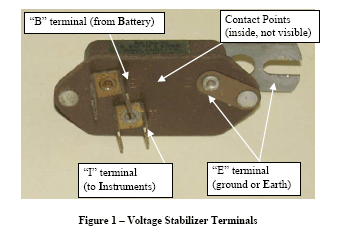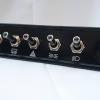
Wiring In Smiths Gauges

Best Answer matt050990 , 31 January 2015 - 05:56 PM
All done :)
Wired in the earth and all working nicely now.
Much ta lads?
Go to the full post 
#1

Posted 29 January 2015 - 10:26 PM
I recently got some smiths gauges from Josh on here for my dash.
I have no exiting wiring for these gauges so they are going in from scratch.
I want to wire them into the existing loom so they light up when I put my lights on the same as my speedo.
I thought I would just be able to 'tap' into the wires that light up the speedo and hey presto but neither gauges lit up when the speedo did.
Is it as easy as that or am I missing something?
The bulbs I bought to light the gauges was these.... http://m.ebay.co.uk/...d=1325699978018
Any suggestions needed.
Much ta
Matt
#2

Posted 29 January 2015 - 10:35 PM
It looks like those bulb holders each through the housing - have you earthed them at all as otherwise they won't work!
Hopefully you haven't used those scotchlock things to patch in either.
Any problems give us a shout as we've wired up these gauges a few times for members now.
David
Edited by Wilson1330, 29 January 2015 - 10:44 PM.
#3

Posted 30 January 2015 - 06:08 AM
Thanks for the response.
No I haven't used them scotchlock things just tried connecting them via bullet connectors so could be removed in future if needed.
How would j go about earthing them? I thought it would be the same as the ones on the speedo, self earthing? Or am I talking flabberdash as per normal?
Cheers
Matt
Edited by matt050990, 30 January 2015 - 06:09 AM.
#4

Posted 30 January 2015 - 06:56 AM
Speeding off without looking properly.
I need to earth the gauges!
I'll earth these into the existing speedo earth and see how that goes!
#5

Posted 30 January 2015 - 12:49 PM
The old way of providing earth to the 52mm gauges was to crimp a ring terminal on a black wire and put the terminal on/under the stud and nut for the gauge mounting bracket. You can splice the other end of the wire into an existing earth wire if you want to. Alternatively you can secure the other end of the black wire to any bare metal point under/behind the dash or on the car's chassis using a screw.
Please remember that you are using Smiths gauges, not generic aftermarket gauges. The Smiths gauges require a 10V power supply for operation. For Smiths gauges this is typically handled by the voltage stabilizer which is attached to the back of the speedometer somewhere. On later Nippon Seiki gauges the stabilizer is built into the gauge cluster and not easily accessible. If you fail to provide the 10V supply and wire your new gauges directly into the car's wiring the gauges will be operating with as much as 14.5V when the car is running which will make the gauges read high and shorten their life. Smiths electromechanical and electronic solid-state voltage stabilizers are available from many sources, including eBay. Note that the voltage stabilizer does not power the tachometer... that does run on full car/system voltage.
I know that the prevailing tone is that ScotchBlocks are bad/evil. However, they are just an insulation displacement type connector like so many others that are around you that you don't think about. ScotchBlocks can work perfectly well as taps if you use the correct one for the wire size you are working with. They are not a "one size fits all" component. Just like crimp style terminals, the different colors ScotchBlocks are molded in have meaning.
#6

Posted 30 January 2015 - 01:00 PM
Thanks for the reply DKLawson,
The earth I will connect to the earth on the speddo to keep it nice and neat.
With regards to the voltage stabilizers, my car only has the single centre speedo and im wiring these in as extras, would my speedo still already have this stabilizer?
I was thinking of just 'tapping' into the wiring for the existing lights to power the gauages can this be done?
Cheers
Matt
#7

Posted 30 January 2015 - 03:15 PM
With the single center speedo the voltage stabilizer will be on the top, back of the speedometer. It is a little rectangular box with wires going to and from it. There will be a dark green wire going "in" to the stabilizer's "B" terminal and light green wires going "out" from the stabilizer (to the gauges) via the "I" terminal. Your car will have the stabilizer probably with a single light green wire going off to the fuel gauge. See the picture linked below of a Smiths stabilizer so you will know what to look for.
The dash lights on the back of the center speedo probably have "red" or red/white wires. You will be able to splice/tap into that wiring for your new gauges without issue.
Smiths electromechanical voltage stabilizer picture:

#8

Posted 30 January 2015 - 04:30 PM
Cheers
Matt
#9

Posted 31 January 2015 - 05:56 PM Best Answer
Wired in the earth and all working nicely now.
Much ta lads?
#10

Posted 25 June 2015 - 10:11 AM
The old way of providing earth to the 52mm gauges was to crimp a ring terminal on a black wire and put the terminal on/under the stud and nut for the gauge mounting bracket. You can splice the other end of the wire into an existing earth wire if you want to. Alternatively you can secure the other end of the black wire to any bare metal point under/behind the dash or on the car's chassis using a screw.
Please remember that you are using Smiths gauges, not generic aftermarket gauges. The Smiths gauges require a 10V power supply for operation. For Smiths gauges this is typically handled by the voltage stabilizer which is attached to the back of the speedometer somewhere. On later Nippon Seiki gauges the stabilizer is built into the gauge cluster and not easily accessible. If you fail to provide the 10V supply and wire your new gauges directly into the car's wiring the gauges will be operating with as much as 14.5V when the car is running which will make the gauges read high and shorten their life. Smiths electromechanical and electronic solid-state voltage stabilizers are available from many sources, including eBay. Note that the voltage stabilizer does not power the tachometer... that does run on full car/system voltage.
I know that the prevailing tone is that ScotchBlocks are bad/evil. However, they are just an insulation displacement type connector like so many others that are around you that you don't think about. ScotchBlocks can work perfectly well as taps if you use the correct one for the wire size you are working with. They are not a "one size fits all" component. Just like crimp style terminals, the different colors ScotchBlocks are molded in have meaning.
Hi,
I have a question, I have a RVI type tachometer, which operates with pulse signal. Do i have to power it up using the 10V line coming from the voltage stabilizer or can i power it up using the car normal 14V wiring?
Regards.
#11

Posted 25 June 2015 - 12:54 PM
Hi,
I have a question, I have a RVI type tachometer, which operates with pulse signal. Do i have to power it up using the 10V line coming from the voltage stabilizer or can i power it up using the car normal 14V wiring?
Regards.
Both RVI and RVC tachs are "pulse sensing". Just to be clear, RVI tachs are an older design which measures current pulses. They are sometimes called impulse tachs. They are wired in SERIES with power flowing through the ignition coil (2 wire connection, not 1).
The later RVC tachs are voltage pulse sensing like "modern" tachometers. They use a single sense wire connected to coil (-) in addition normal power connections.
Succinctly, both RVI and RVC tachs will required a switched full voltage supply (12 to 14V). Do not run supply the tachometer with reduced voltage from the stabilizer. Neither the stabilizer nor the tachometer were designed for that connection. The tachs also require an earth connection either through the mounting hardware on the gauge case or a spade lug spot welded to the gauge case. Illumination should be obvious... earth through the case and power for the lamps tapped into the existing dash light circuit.
There are early and late RVI tachs and two wiring schemes possible. Early RVI tachs use a loop of white wire held to the back of the gauge. Later RVI tachs move that loop of wire inside the gauge case and provide male and female bullet connectors on the back of the case instead (for connection of white wires). Factory installations of RVI tachs typically have a white wire leaving the ignition switch, going to the white wire loop on the back of the tach, with an additional white wire leaving the tachometer loop going to the coil (+) terminal. No other wires would be on coil (+). For aftermarket installations, the coil is powered by a white wire from the ignition switch. The RVI tach is wired with one side of its white wire loop connected to coil (-) and the remaining white wire from the gauge loop being connected to the distributor (the points connector).
For RVC tachs, a single bullet connector is on the back of the gauge. A white/black wire is run from that bullet directly to coil (-). That's all that is required in addition to the common power wiring mentioned in my 3rd paragraph.
You can see that the RVC tach is much easier to install. Being a voltage pulse sensing tach it is also more modern and compatible with electronic ignitions while the RVI tach is not.
#12

Posted 25 June 2015 - 01:46 PM
Hi,
I have a question, I have a RVI type tachometer, which operates with pulse signal. Do i have to power it up using the 10V line coming from the voltage stabilizer or can i power it up using the car normal 14V wiring?
Regards.
Both RVI and RVC tachs are "pulse sensing". Just to be clear, RVI tachs are an older design which measures current pulses. They are sometimes called impulse tachs. They are wired in SERIES with power flowing through the ignition coil (2 wire connection, not 1).
The later RVC tachs are voltage pulse sensing like "modern" tachometers. They use a single sense wire connected to coil (-) in addition normal power connections.
Succinctly, both RVI and RVC tachs will required a switched full voltage supply (12 to 14V). Do not run supply the tachometer with reduced voltage from the stabilizer. Neither the stabilizer nor the tachometer were designed for that connection. The tachs also require an earth connection either through the mounting hardware on the gauge case or a spade lug spot welded to the gauge case. Illumination should be obvious... earth through the case and power for the lamps tapped into the existing dash light circuit.
There are early and late RVI tachs and two wiring schemes possible. Early RVI tachs use a loop of white wire held to the back of the gauge. Later RVI tachs move that loop of wire inside the gauge case and provide male and female bullet connectors on the back of the case instead (for connection of white wires). Factory installations of RVI tachs typically have a white wire leaving the ignition switch, going to the white wire loop on the back of the tach, with an additional white wire leaving the tachometer loop going to the coil (+) terminal. No other wires would be on coil (+). For aftermarket installations, the coil is powered by a white wire from the ignition switch. The RVI tach is wired with one side of its white wire loop connected to coil (-) and the remaining white wire from the gauge loop being connected to the distributor (the points connector).
For RVC tachs, a single bullet connector is on the back of the gauge. A white/black wire is run from that bullet directly to coil (-). That's all that is required in addition to the common power wiring mentioned in my 3rd paragraph.
You can see that the RVC tach is much easier to install. Being a voltage pulse sensing tach it is also more modern and compatible with electronic ignitions while the RVI tach is not.
Regards!
#13

Posted 25 June 2015 - 04:29 PM
Your wiring sounds correct.
The earlier statement about wiring Smiths gauges to the stabilizer applies primarily to fuel and temperature gauges. It does not apply to the tachometers.
#14

Posted 29 June 2015 - 09:38 AM
Your wiring sounds correct.
The earlier statement about wiring Smiths gauges to the stabilizer applies primarily to fuel and temperature gauges. It does not apply to the tachometers.
Thank you once again!
Best Regards!
#15

Posted 13 July 2015 - 10:22 AM
I was able to sucessfully install the rev counter. However it seems to be reading 50% more than it should. Is it possible to calibrate? How ?
Edited by RaulSims, 13 July 2015 - 10:47 AM.
0 user(s) are reading this topic
0 members, 0 guests, 0 anonymous users
















